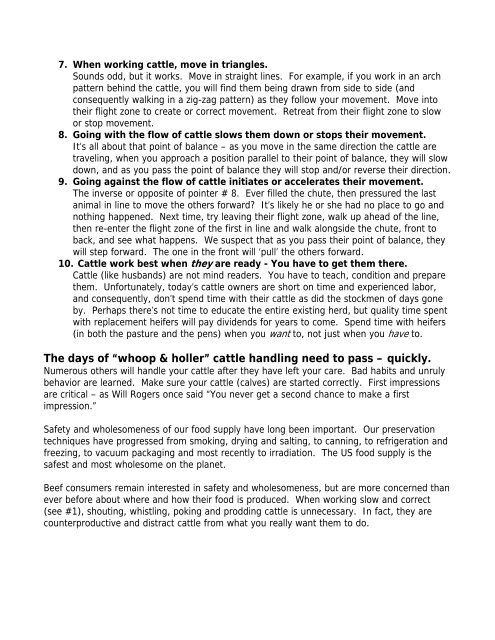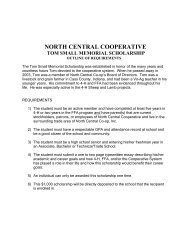Cattle Handling Pointers
Cattle Handling Pointers
Cattle Handling Pointers
Create successful ePaper yourself
Turn your PDF publications into a flip-book with our unique Google optimized e-Paper software.
7. When working cattle, move in triangles.<br />
Sounds odd, but it works. Move in straight lines. For example, if you work in an arch<br />
pattern behind the cattle, you will find them being drawn from side to side (and<br />
consequently walking in a zig-zag pattern) as they follow your movement. Move into<br />
their flight zone to create or correct movement. Retreat from their flight zone to slow<br />
or stop movement.<br />
8. Going with the flow of cattle slows them down or stops their movement.<br />
It’s all about that point of balance – as you move in the same direction the cattle are<br />
traveling, when you approach a position parallel to their point of balance, they will slow<br />
down, and as you pass the point of balance they will stop and/or reverse their direction.<br />
9. Going against the flow of cattle initiates or accelerates their movement.<br />
The inverse or opposite of pointer # 8. Ever filled the chute, then pressured the last<br />
animal in line to move the others forward? It’s likely he or she had no place to go and<br />
nothing happened. Next time, try leaving their flight zone, walk up ahead of the line,<br />
then re-enter the flight zone of the first in line and walk alongside the chute, front to<br />
back, and see what happens. We suspect that as you pass their point of balance, they<br />
will step forward. The one in the front will ‘pull’ the others forward.<br />
10. <strong>Cattle</strong> work best when they are ready - You have to get them there.<br />
<strong>Cattle</strong> (like husbands) are not mind readers. You have to teach, condition and prepare<br />
them. Unfortunately, today’s cattle owners are short on time and experienced labor,<br />
and consequently, don’t spend time with their cattle as did the stockmen of days gone<br />
by. Perhaps there’s not time to educate the entire existing herd, but quality time spent<br />
with replacement heifers will pay dividends for years to come. Spend time with heifers<br />
(in both the pasture and the pens) when you wan to, not just when you have to.<br />
The days of “whoop & holler” cattle handling need to pass – quickly.<br />
Numerous others will handle your cattle after they have left your care. Bad habits and unruly<br />
behavior are learned. Make sure your cattle (calves) are started correctly. First impressions<br />
are critical – as Will Rogers once said “You never get a second chance to make a first<br />
impression.”<br />
Safety and wholesomeness of our food supply have long been important. Our preservation<br />
techniques have progressed from smoking, drying and salting, to canning, to refrigeration and<br />
freezing, to vacuum packaging and most recently to irradiation. The US food supply is the<br />
safest and most wholesome on the planet.<br />
Beef consumers remain interested in safety and wholesomeness, but are more concerned than<br />
ever before about where and how their food is produced. When working slow and correct<br />
(see #1), shouting, whistling, poking and prodding cattle is unnecessary. In fact, they are<br />
counterproductive and distract cattle from what you really want them to do.



